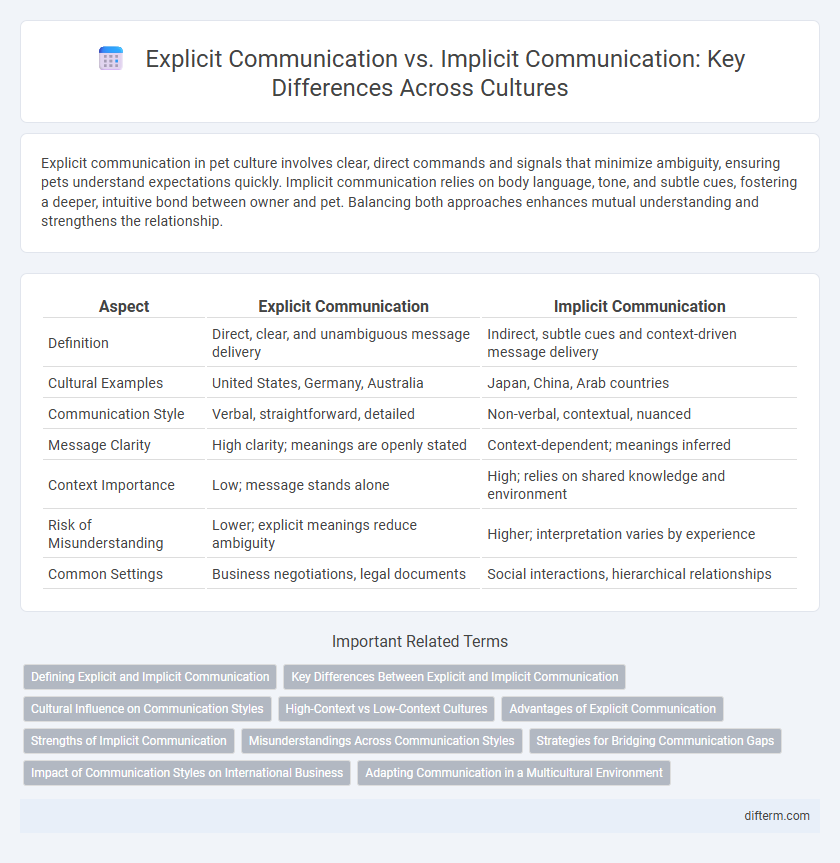Explicit communication in pet culture involves clear, direct commands and signals that minimize ambiguity, ensuring pets understand expectations quickly. Implicit communication relies on body language, tone, and subtle cues, fostering a deeper, intuitive bond between owner and pet. Balancing both approaches enhances mutual understanding and strengthens the relationship.
Table of Comparison
| Aspect | Explicit Communication | Implicit Communication |
|---|---|---|
| Definition | Direct, clear, and unambiguous message delivery | Indirect, subtle cues and context-driven message delivery |
| Cultural Examples | United States, Germany, Australia | Japan, China, Arab countries |
| Communication Style | Verbal, straightforward, detailed | Non-verbal, contextual, nuanced |
| Message Clarity | High clarity; meanings are openly stated | Context-dependent; meanings inferred |
| Context Importance | Low; message stands alone | High; relies on shared knowledge and environment |
| Risk of Misunderstanding | Lower; explicit meanings reduce ambiguity | Higher; interpretation varies by experience |
| Common Settings | Business negotiations, legal documents | Social interactions, hierarchical relationships |
Defining Explicit and Implicit Communication
Explicit communication involves clear, direct expressions where the speaker's intentions and messages are openly stated, reducing ambiguity. Implicit communication relies on context, nonverbal cues, and shared understandings to convey meaning without overt statements. These communication styles significantly influence cross-cultural interactions, shaping how information is interpreted and exchanged.
Key Differences Between Explicit and Implicit Communication
Explicit communication relies on clear, direct language where the message is fully spelled out, minimizing ambiguity and ensuring precise understanding. Implicit communication depends on context, nonverbal cues, and shared cultural knowledge, often requiring interpretation beyond the spoken words. Key differences include the degree of clarity, the role of context, and the reliance on verbal versus nonverbal information to convey meaning effectively.
Cultural Influence on Communication Styles
Cultural norms significantly influence communication styles, differentiating explicit communication--common in low-context cultures such as the United States and Germany--from implicit communication typical in high-context cultures like Japan and Saudi Arabia. In explicit communication, messages are conveyed clearly and directly, minimizing ambiguity, whereas implicit communication relies heavily on nonverbal cues, context, and shared understanding to convey meaning. This cultural divergence affects interpersonal interactions, business negotiations, and conflict resolution strategies across diverse cultural settings.
High-Context vs Low-Context Cultures
High-context cultures rely heavily on implicit communication, where meaning is derived from context, non-verbal cues, and shared experiences, commonly seen in countries like Japan and China. Low-context cultures emphasize explicit communication, preferring clear, direct, and detailed verbal messages typical in the United States and Germany. Understanding these differences is essential for effective cross-cultural interaction and reducing miscommunication in global business and social environments.
Advantages of Explicit Communication
Explicit communication ensures clarity by conveying messages directly, reducing misunderstandings and ambiguity in cross-cultural interactions. It facilitates efficient information exchange, especially in international business settings where precise instructions and expectations are crucial. This approach enhances accountability and transparency, fostering trust and smoother collaboration among diverse teams.
Strengths of Implicit Communication
Implicit communication leverages nonverbal cues, context, and shared understanding to convey messages efficiently, reducing the need for lengthy explanations and fostering harmony in social interactions. This style enhances relationship-building by emphasizing emotional nuance and cultural sensitivity, allowing individuals to interpret meanings beyond words. It is particularly effective in high-context cultures where mutual trust and subtlety are valued, enabling deeper connections and minimizing conflicts.
Misunderstandings Across Communication Styles
Explicit communication relies on clear, direct language where meanings are stated openly, minimizing ambiguity in interactions. Implicit communication conveys messages through context, tone, and nonverbal cues, often requiring shared cultural knowledge to interpret accurately. Misunderstandings occur frequently when individuals from low-context (explicit) cultures interact with high-context (implicit) cultures, as expectations for clarity and inference differ significantly.
Strategies for Bridging Communication Gaps
Bridging communication gaps between explicit and implicit communicators requires developing cultural awareness and adapting communication strategies to context. Active listening and asking clarifying questions help ensure mutual understanding while respecting differing conversational norms. Implementing culturally sensitive training programs enhances cross-cultural competence and reduces misunderstandings in diverse environments.
Impact of Communication Styles on International Business
Direct explicit communication fosters clarity and reduces misunderstandings in international business negotiations, especially with low-context cultures such as Germany and the United States. Conversely, implicit communication prevalent in high-context cultures like Japan and China relies on nonverbal cues and indirect messages, which can lead to misinterpretations if not properly understood. Adapting communication strategies to align with cultural expectations enhances relationship building and negotiation effectiveness across global markets.
Adapting Communication in a Multicultural Environment
Adapting communication in a multicultural environment requires understanding the differences between explicit and implicit communication styles. Explicit communication involves clear, direct messages often preferred in cultures like the United States and Germany, while implicit communication relies on context, non-verbal cues, and indirect expressions common in Japan and China. Recognizing these differences enhances cross-cultural interactions, reduces misunderstandings, and fosters effective collaboration in diverse workplaces.
explicit communication vs implicit communication Infographic

 difterm.com
difterm.com